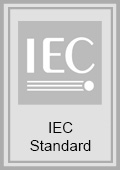
A IEC (International Electrotechnical Commission) é a organização líder mundial que prepara e publica normas internacionais para todas as tecnologias elétricas, eletrônicas e relacionadas. É também uma das três únicas organizações globais (IEC, ISO, ITU) que desenvolvem Normas Internacionais para o mundo todo.
Mais de 10.000 grupos de especialistas da indústria, comércio, governo, laboratórios de teste e pesquisas, do setor acadêmico e consumidores participam do trabalho de normalização na IEC.
Quando necessário, a IEC trabalha em sistema de cooperação com a ISO (International Organization for Standardization) ou com a ITU (International Telecommunication Union) para garantir que as normas internacionais se encaixem e se complementem perfeitamente. Comissões mistas garantem que as normas internacionais combinem todo o conhecimento relevante dos especialistas que atuam em áreas co-relacionadas.
| Arc welding equipment - Part 1: Welding power sources | |
| Publication date 2017-02 | |
This part of IEC 60974 is applicable to power sources for arc welding and allied processes designed for industrial and professional use, and supplied by a voltage not exceeding 1 000 V, battery supplied or driven by mechanical means. This document specifies safety and performance requirements of welding power sources and plasma cutting systems. |
| Estimation of the reliability of electrical connectors | |
| Publication date 2017-01 | |
IEC TS 61586:2017 deals with the estimation of the inherent design reliability of electrical connectors through the definition and development of an appropriate accelerated testing programme. The basic intrinsic degradation mechanisms of connectors, which are those mechanisms which exist as a result of the materials and geometries chosen for the connector design, are reviewed to provide a context for the development of the desired test programme. While extrinsic degradation mechanisms may also significantly affect the performance of connectors, they vary widely by application and thus are not addressed in this document. This second edition cancels and replaces the first edition published in 1997. |
| Rotating electrical machines - Part 18-42: Partial discharge resistant electrical insulation systems (Type II) used in rotating electrical machines fed from voltage converters - Qualification tests | |
| Publication date 2017-02 | |
EC 60034-18-42:2017 defines criteria for assessing the insulation system of stator/rotor windings of single or polyphase AC machines which are subjected to repetitive impulse voltages, such as those generated by pulse width modulation (PWM) converters, and are expected to experience and withstand partial discharge activity during service. It specifies electrical qualification tests on representative specimens to verify fitness for operation with voltage-source converters. It also describes an additional classification system which defines the limits of reliable performance under converter-fed conditions. |
| Optical fibres - Part 1-60: Measurement methods and test procedures - Beat length | |
| Publication date 2017-02 | |
IEC 60793-1-60: 2017 defines test methods for both the phase beat length, and the group beat length. These two parameters are defined differently, and will give different results depending on the type of polarization-maintaining (PM) fibre. The phase beat length is the relevant parameter for the fibres ability to maintain a high extinction ratio. This is described in more details in Annexes A and B. |
| Optical fibres - Part 1-61: Measurement methods and test procedures - Polarization crosstalk | |
| Publication date 2017-02 | |
EC 60793-1-61: 2017 establishes uniform requirements for measuring the polarization crosstalk of polarization-maintaining (PM) fibres. This document gives two methods for measuring the polarization crosstalk of PM fibres. Method A is the power ratio method, which uses the maximum and minimum values of output power at a specified wavelength, and Method B is the in-line method, which uses an analysis of the Poincaré sphere. Details of each method are described in Clause 6. Crosstalk values obtained by Methods A and B are based on different definitions. The crosstalk measured by Method A is defined as an "averaged" value over a measured wavelength range. In contrast, the crosstalk value obtained from Method B shows the "worst case" crosstalk value. |
| Amendment 1 - Safety requirements for electrical equipment for measurement, control, and laboratory use - Part 1: General requirements | |
| Publication date 2016-12 | |
|
